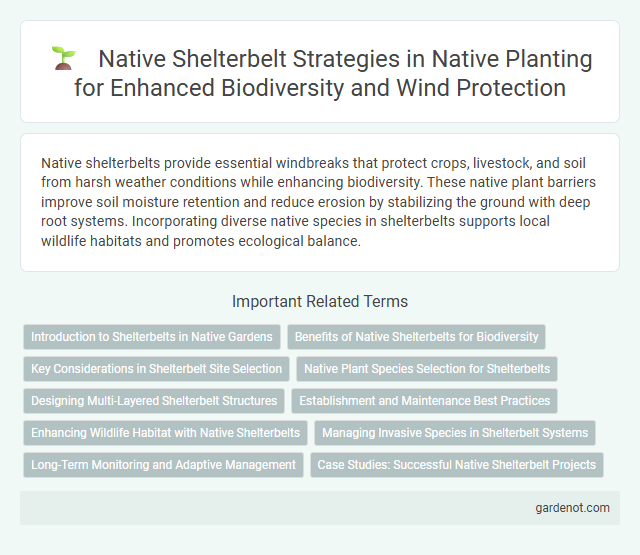Native shelterbelts provide essential windbreaks that protect crops, livestock, and soil from harsh weather conditions while enhancing biodiversity. These native plant barriers improve soil moisture retention and reduce erosion by stabilizing the ground with deep root systems. Incorporating diverse native species in shelterbelts supports local wildlife habitats and promotes ecological balance.
Introduction to Shelterbelts in Native Gardens
Native shelterbelts consist of strategically planted rows of indigenous trees and shrubs designed to protect gardens from wind erosion and temperature extremes. These plantings enhance biodiversity by providing habitat for local wildlife, improving soil quality, and conserving moisture in native garden ecosystems. Integrating native shelterbelts promotes sustainability and resilience in garden landscapes through natural windbreak and microclimate regulation.
Benefits of Native Shelterbelts for Biodiversity
Native shelterbelts provide critical habitat corridors that enhance biodiversity by supporting diverse wildlife species and native plants. They improve ecosystem resilience by maintaining soil health, reducing erosion, and fostering pollinator populations essential for plant reproduction. Shelterbelts also contribute to genetic diversity by connecting fragmented habitats, enabling species migration and adaptation.
Key Considerations in Shelterbelt Site Selection
Soil type and drainage critically influence native shelterbelt site selection, ensuring optimal tree growth and longevity. Exposure to prevailing winds and microclimatic conditions must be assessed to maximize windbreak effectiveness and protect surrounding areas. Proximity to existing native vegetation supports biodiversity and enhances ecological connectivity within the shelterbelt zone.
Native Plant Species Selection for Shelterbelts
Selecting native plant species for shelterbelts enhances biodiversity and ecosystem resilience by providing habitat and food for local wildlife. Species such as Eastern Red Cedar, American Plum, and Black Chokeberry are ideal due to their adaptability to local soil and climate conditions, as well as their dense foliage that effectively reduces wind erosion. Incorporating a mix of trees and shrubs tailored to regional ecosystems optimizes windbreak efficiency and supports pollinators and bird populations.
Designing Multi-Layered Shelterbelt Structures
Designing multi-layered native shelterbelt structures involves strategically selecting diverse plant species with varying heights, root depths, and growth rates to maximize windbreak efficiency and biodiversity. Incorporating grasses, shrubs, and trees in successive layers enhances soil stabilization, provides habitat for wildlife, and improves microclimate conditions. Effective shelterbelt design optimizes moisture retention and reduces erosion while supporting native ecosystems' resilience.
Establishment and Maintenance Best Practices
Establishing a native shelterbelt requires selecting locally adapted plant species that provide effective windbreaks and wildlife habitat, with site preparation including soil testing and weed control to improve survival rates. Regular maintenance involves mulching, targeted pruning, and monitoring for pests or diseases, ensuring the shelterbelt remains healthy and functional over time. Integrating native grasses and shrubs around the trees enhances biodiversity and soil stability, promoting a resilient ecosystem.
Enhancing Wildlife Habitat with Native Shelterbelts
Native shelterbelts composed of diverse local tree and shrub species create essential wildlife corridors that support biodiversity and ecological balance. These plantings provide critical nesting sites, food sources, and protective cover for birds, mammals, and beneficial insects. Implementing native shelterbelts enhances habitat connectivity, promoting species resilience and sustainable ecosystem health.
Managing Invasive Species in Shelterbelt Systems
Managing invasive species in native shelterbelt systems requires regular monitoring to identify early infestations and prevent their spread. Employing targeted mechanical removal, controlled burns, or selective herbicide applications helps maintain native plant health and biodiversity. Integrating diverse native species enhances ecosystem resilience, reducing the vulnerability of shelterbelts to invasive species dominance.
Long-Term Monitoring and Adaptive Management
Long-term monitoring of native shelterbelts is essential for assessing ecosystem health, biodiversity support, and soil stability over time. Adaptive management strategies involve regularly analyzing data on plant growth, wildlife usage, and climatic impacts to refine planting techniques and species selection. This continuous feedback loop ensures that shelterbelts remain effective against erosion while enhancing native habitat resilience.
Case Studies: Successful Native Shelterbelt Projects
Native shelterbelt projects demonstrate significant environmental benefits by using indigenous plant species to improve soil health and increase biodiversity. Case studies from the Midwest United States highlight how strategic planting of native trees and shrubs reduces wind erosion and creates habitat corridors for wildlife. These successful projects emphasize the importance of species selection and planting design tailored to local ecosystems for long-term sustainability.
Native shelterbelt Infographic

 gardenot.com
gardenot.com